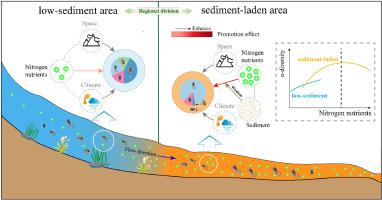高泥沙负荷削弱了氮营养物对大陆尺度河流浮游动物多样性的影响
IF 8.4
2区 环境科学与生态学
Q1 ENVIRONMENTAL SCIENCES
引用次数: 0
摘要
悬浮泥沙是驱动含沙河流生物多样性的主要因素。然而,在大型含沙河流中,水生群落的组成及其多样性对沉积物-营养物相互作用的响应在很大程度上尚未被探索。对黄河干流浮游动物群落的分布格局进行了研究。从河源到河口共采集了41个采样断面。根据水样含沙量,将研究区划分为低含沙量区(区1)和含沙量区(区2)。研究区浮游动物样本共鉴定出164种,区2的物种数量和密度均显著高于区1。非度量多维尺度和相似性分析揭示了不同区域浮游动物群落组成的显著差异。在空间因子对群落变化贡献突出的同时,环境过滤的作用也不容忽视。氮养分是影响区域1浮游动物群落的主要环境因子。除氮营养物外,总悬浮物和浊度也对2区浮游动物群落产生强烈影响。高泥沙负荷削弱了氮营养物对浮游动物多样性的积极作用。值得注意的是,泥沙效应并未导致物种损失,但导致氮对群落多样性的限制提前。本研究提供了对大陆尺度含沙河流系统浮游动物群落动态的机制洞察,揭示了水生群落对悬浮沉积物的响应模式。本文章由计算机程序翻译,如有差异,请以英文原文为准。

High sediment load weakens the effects of nitrogen nutrients on zooplankton diversity in a continental-scale river
Suspended sediment is a major factor driving biodiversity in sediment-laden rivers. However, the composition of aquatic communities and their diversity responses to sediment–nutrient interactions in large-scale sediment-laden rivers are largely unexplored. This study investigated the distribution patterns of zooplankton communities in the main stream of the Yellow River, China. Samples were collected in 41 sampling sections spanning from the river source to the estuary. Based on the sediment concentration of water samples, the study area was divided into a low-sediment region (region 1) and a sediment-laden region (region 2). A total of 164 species were identified in zooplankton samples, with significantly higher species number and density in region 2 compared to region 1. Non-metric multidimensional scaling and analysis of similarities revealed pronounced differences in zooplankton community composition across regions. Despite the prominent contribution of spatial factors to community variations, environmental filtering played a non-negligible role. Nitrogen nutrients emerged as overarching environmental factors shaping zooplankton communities in region 1. In addition to nitrogen nutrients, total suspended solids and turbidity also strongly affected zooplankton communities in region 2. High sediment load weakened the positive effects of nitrogen nutrients on zooplankton diversity. Notably, the sediment effect did not result in species loss, but led to an earlier nitrogen limitation on community diversity. This study provides mechanistic insight into zooplankton community dynamics in a continental-scale sediment-laden river system, unveiling the response patterns of aquatic communities to suspended sediment.
求助全文
通过发布文献求助,成功后即可免费获取论文全文。
去求助
来源期刊

Journal of Environmental Management
环境科学-环境科学
CiteScore
13.70
自引率
5.70%
发文量
2477
审稿时长
84 days
期刊介绍:
The Journal of Environmental Management is a journal for the publication of peer reviewed, original research for all aspects of management and the managed use of the environment, both natural and man-made.Critical review articles are also welcome; submission of these is strongly encouraged.
 求助内容:
求助内容: 应助结果提醒方式:
应助结果提醒方式:


